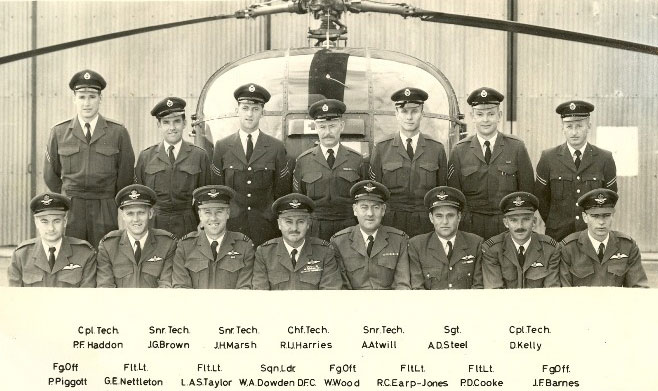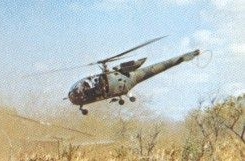7 Sqn Photo Gallery Simmo's Armoured Seat Trooping - Dummy Drops Air Force Home Page Site Home Page
Formation: 28th February 1962
Motto: "Fight Anywhere And Everywhere"
Roles: The roles of No 7 Squadron, equipped with Allouette III aircraft, were troop transport, casevac and battlefield support including Fireforce.
Some of these aircraft (G cars) were fitted with twin .303 machine guns. These twin Brownings replaced the Fabrique Nationale 7.62 machine gun as the 7.62 was not considered efficient as an air to ground weapon as it had a low rate of fire. The twin Brownings which originated from the Provost aircraft when they were phased out had by comparison a very high rate of fire. Some Alloutte III aircraft were configured as gunships (known as K cars). These were armed with a 20 mm cannon firing high explosive incendiary rounds. Some trials were conducted using .5in Browning machine guns but these were not as effective as the 20mm cannon.
A Brief History
No 7 Squadron was established at New Sarum Air Force Base on the South side of Salisbury from where it operated a number of Allouette III helicopters.
Initially about a dozen Allouette III helicopters were procured. These remained in service until Zimbabwe Independence. The number of aircraft varied considerably during this period as additional aircraft were acquired. Some aircraft were destroyed during operations.
The Allouette was a very useful acquisition and it's simple construction made it relatively easy to maintain. Some aircraft that would under normal circumstances have been written off after sustaining serious damage were repaired and returned to service. Much credit must go to the men who maintained the aircraft and in particular to those who worked in the ASF who were responsible for the rebuilding of the aircraft.
1964
1st January 1964 Squadron Leader Ossie Penton took over as OC No 7 Sqn from Squadron Leader Bill Dowden.
August 1964 a Helicopter flown by Flight Lieutenant Peter Cooke with Flying Officer Dave Becks, Warrant Officer Taff Powell on board flew into Lake MacLlwaine during an exercise to determine whether safe operation over water at night was possible.
During the late 60's and early 70's the pilots were usually posted to the squadron from No 4 Squadron where they had learned all about close cooperation with the army and police in the field. This meant that having completed the conversion onto the aircraft they were ready for deployment to the field. Whilst their role was different their understanding of the way the army operated and how the troops on the ground were used was already understood. Many of the new pilots had several years experience in anti terrorist operations.
In the latter years of the conflict due to pilot shortages, some pilots were posted directly to No 7 Squadron as their first posting.
The flight engineers on the aircraft were trained as Air Gunners as part of their task was to operate the 20 mm cannon or the .303 machine gun on the K-car, or the .762 machine gun on the G-cars.
These engineers wore a brevet with a single wing to indicate their qualification.
1967
By the end of 1967 No 7 Squadron was committed to maintain helicopters on a semi-perminent basis at both Wankie (FAF 1) and Kariba (FAF2)
1968
In 1968 No 7 Squadron was awarded the Jacklin Trophy (Second Award)
1970
1st July 1970, No 7 Squadron suffered its first fatality when a helicopter crashed outside the main gate of New Sarum shortly before midday killing Squadron Leader Gordon Nettelton and Flight Lieutenant Michael Hill. No explanation was found for this crash. The theory behind the accident was that the pilot had suffered fro flicker vertigo.
1972
17th January 1972 Flight Lieutenant Guy Munton-Jackson and Flight Sergeant Peter Gardner were killed when their aircraft crashed near Que Que at night in rain. There was no clear reason for the crash however bad weather and spatial disorientation were definitely contributory factors.
In august 1972 Flight Lieutenant John Annan was involved in
the rescue of Mrs Ashton who fell 125 meters at Mtarazi Falls. John
hovered his helicopter 15 meters above the woman who had been lying in
the cold for more than 20 hours as she was winched to safety.
1973
21st February 1973 Air Lieutenant John Smart and
Sergeant Kevin (Tinker) Smithdorff were killed when their aircraft hit
a tree in the Rushinga area during routine operations. The aircraft was
found in thick bush on the banks of the Ruya River five days later
after an intensive search and rescue operation.
August 1973, Flight Lieutenant Ian Harvey became the first
Rhodesian pilot to fly 2,000 hours in an Allouette III helicopter.
November 1973, Squadron Leader Eddie Wilkinson crashed AFTER he flew into telephone lines near Mtoko. Both he and Sergeant Duncan Woods received injuries. The aircraft sustained serious damage.
20th December 1973 a helicopter flown by Air Lieutenant Dave Row and Sergeant Carl de Beer was hit by ground fire. Dave was hit in the right arm and leg. It became obvious that Dave was not able to fly the aircraft back to base . Dave briefed Carl on the use of the collective pitch lever and as a team they managed to land the aircraft safely much to the relief of their army passengers. The aircraft was only slightly damaged by the ground fire. Both men were awarded the MFC for their action.
1974
In March 1974 the first 20mm gun was mounted and used on an Allouette III helicopter which would hence forth be call the K-Car (killer)
1979
18th May 1979 the squadron was presented with their colours by Air Marshall F. W. Mussell
1980
After Independence of Zimbabwe No 8 Squadron and No 7 Squadron were amalgamated due to there being a lack of serviceable aircraft and crews.
1983
Some time later (1983) the squadron was reformed when the Zimbabwe Air Force acquired two Augusta Bell 412 aircraft. In April 1988 these were augmented with a further 10 similar aircraft. In April 1995 2 AS 532 Cougar helicopters were added to the squadron.
Squadron Commanders

Absent: Sqn Ldr G. Nettleton, (1969 - 1970), Sqn Ldr H Griffiths, (1975 - 1977), Sqn Ldr W.G. Cronshaw, (1878)
The Original 7 Squadron (1962)

Comment from John Barnes
This was the original 7 Sqn complement - aircrew and ground crew.
Sqn Ldr Dowden and Flt Lt Earp-Jones were trained in France by then Sud Aviation. The rest of the pilots were trained/converted
with the SAAF - 17 Sqn at Ysterplaat, Cape Town and Snake Valley, Pretoria, (it was quite a rough time for us -forced to drink
Lieberstein wine (25cents a bottle) cooled in the icy waters at Clifton beach, surrounded by lovely Capetonian girls!
Peter Piggott and I were single then and got blamed for a lot of things I don't remember!. Rex Taylor stayed on a while in Pretoria
to train as a QHI.
The spanner bashers I am not certain about their training other than some were trained in France. In any case they and all spanner
bashers in our splendid air force always did a fantastic job in maintaining our fleet. Sandy Steels gong was a British GSM for
Aden(?),Rex Earp-Jones had gongs from his SAAF time in Korea.



















